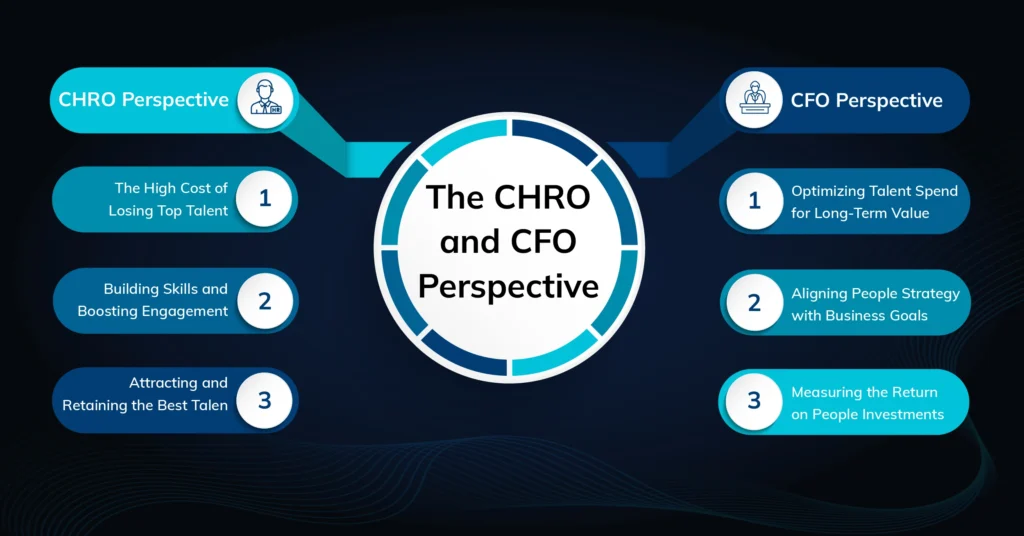In today’s dynamic business landscape, attracting and retaining top talent isn’t just a human resources (HR) concern – it’s a strategic measure for long-term financial health. This is where the often-overlooked partnership between Chief Human Resources Officers (CHROs) and Chief Financial Officers (CFOs) becomes a game-changer. By working together, these seemingly disparate leaders can develop sustainable talent strategies that fuel business growth while maintaining financial prudence.
The CHRO is a critical player in talent management, crafting strategies that attract high performers and play a crucial role in cultivating a positive work environment. This environment fosters retention and is a significant factor in the success of sustainable talent strategies. Conversely, the CFO brings financial expertise, ensuring talent investments are strategically sustainable and deliver a strong return on investment (ROI).
While both CHROs and CFOs are essential players, their areas of influence can sometimes appear to be at odds. The CHRO might advocate for talent development programs or competitive compensation packages, while the CFO focuses on cost optimization. However, the most successful organizations are realizing the power of a collaborative approach. When CHROs and CFOs work together, they can create a powerful synergy that transforms talent strategy into a balancing act into a well-coordinated dance, inspiring and motivating the entire organization to achieve greater heights.
This article explains the importance of healthy co-functionality between the CHRO and CFO and how it can be a game-changer for your organization.
The War for Talent and the Bottom Line
The current talent market is fiercely competitive. Skilled workers have options, and companies struggling to attract and retain them face a domino effect. High turnover rates, with their significant financial implications, lead to decreased productivity, increased costs associated with recruitment and onboarding, and a decline in morale among remaining employees. A Society for Human Resource Management (SHRM) report found that the direct and indirect costs of replacing salaried employees can range from three to four times their annual salary. This ultimately impacts the bottom line, underscoring the urgency for a collaborative approach.
The direct and indirect costs of replacing salaried employees can range from three to four times their annual salary.
The CHRO Perspective: Investing in Your People, Investing in Your Future
The High Cost of Losing Top Talent
Employee turnover is a significant drain on any organization. The cost of replacing a lost employee can reach up to twice their annual salary, including factors like recruitment, onboarding, and lost productivity.
Building Skills and Boosting Engagement
Investing in employee development is critical for building a future-proof workforce. Training programs, mentorship opportunities, and clear career paths enhance skills and boost employee engagement. Engaged employees are more productive, satisfied, and less likely to leave.
Attracting and Retaining the Best
A strong employer brand is a critical differentiator in the talent market. CHROs focus on creating a positive company culture, competitive compensation packages, and attractive benefits to attract and retain top talent.
The CFO Perspective: Talent is an Investment, Not Just a Cost
Optimizing Talent Spend for Long-Term Value
CFOs understand that talent is not just an expense but a strategic investment. By analyzing workforce data and identifying areas for cost optimization, they can ensure talent spend aligns with business needs.
Aligning People Strategy with Business Goals
A successful talent strategy is tied to the organization’s overall business goals. CFOs work with CHROs to ensure that talent acquisition, development, and retention programs support the company’s strategic objectives.
Measuring the Return on People Investments
While talent is an investment, it’s essential to measure its return. CFOs advocate for metrics that track the impact of people programs on crucial business outcomes, such as revenue growth, customer satisfaction, and innovation.
The Real Business Impact of CHRO & CFO Collaboration
Traditionally, CHROs have focused on employee well-being, engagement, and development, while CFOs have prioritized financial performance and cost control. However, the lines are blurring. A skilled and motivated workforce is no longer a “soft” cost but a strategic investment directly impacting financial sustainability.
Why collaboration between CHROs and CFOs is critical?
Data-Driven Decision Making
Strategic Talent Investment
Cost Management with a Human Touch
Risk Mitigation
Here’s why collaboration between CHROs and CFOs is critical:
Data-Driven Decision Making
Both HR and finance departments have access to valuable data. CHROs can provide insights into employee performance, engagement levels, and turnover rates. CFOs can analyze the financial impact of talent-related decisions. Combining these data sets allows them to develop talent strategies based on a holistic understanding of the business and its workforce.
Strategic Talent Investment
CFOs can help CHROs prioritize talent investments that deliver a strong return on investment (ROI). Evaluating the financial impact of talent acquisition programs, training initiatives, and employee wellness programs allows for a more strategic allocation of resources.
Cost Management with a Human Touch
CFOs are naturally cost-conscious, but effective talent management isn’t just about cost-cutting. Working together, CHROs and CFOs can develop strategies that control costs while fostering a positive work environment. This could include investing in upskilling existing employees to avoid expensive external hires or offering competitive compensation packages without exceeding budget constraints.
Risk Mitigation
A strong talent strategy helps mitigate workforce-related risks. High turnover rates, low employee morale, and skill gaps can all negatively impact a company’s financial performance. By proactively addressing these issues, CHROs and CFOs can protect the company’s bottom line.
Building a Collaborative CHRO-CFO Powerhouse: Strategies for Successful Talent Operations
Fostering a solid working relationship between CHROs and CFOs goes beyond simply acknowledging its benefits. It requires concrete actions and a commitment to breaking down traditional silos. Here’s a deeper dive into building a collaborative CHRO-CFO relationship:
1. Alignment Through Shared Data
Joint Budget Planning Sessions
Moving beyond departmental proposals, collaborative planning sessions allow CHROs to present talent acquisition needs, demonstrating return on investment (ROI), such as increased productivity or reduced recruitment costs. CFOs can then analyze affordability and long-term financial impact, ensuring talent investments align with strategic goals.
Workforce Analytics Task Force
A cross-functional task force comprising HR and finance representatives can analyze workforce data together. This allows for identifying trends and measuring the true impact of HR initiatives on financial metrics like cost-per-hire and employee turnover rates. This data-driven approach empowers the development of talent strategies with a strong focus on the bottom line.
Succession Planning Power Play
A robust succession plan for critical leadership roles minimizes disruption and associated costs during transitions. By partnering with the CFO, CHROs can identify high-potential internal talent and invest in their development, ensuring a smooth handover and financial stability.
2. Communication: Building Bridges for Shared Success
Regular Strategic Check-Ins
Scheduling dedicated meetings fosters communication. These meetings allow for discussion of talent management issues, updates on ongoing initiatives, and proactive addressing of challenges together. Consistent communication ensures alignment and that both leaders are on the same page.
Shared Dashboards & Real-Time Insights
Co-development of a system with real-time dashboards provides CHROs and CFOs with crucial talent and financial metrics. This transparency fosters trust and facilitates data-driven decision-making.
Cross-Departmental Learning Sessions
Organizing joint training sessions allows HR professionals to gain basic financial literacy and CFOs to learn about core HR metrics and talent management challenges. This mutual understanding creates a shared language that fuels effective collaboration.
3. Building a Collaborative Culture: Fostering Trust
Joint Leadership Retreats
Facilitating off-site retreats allows CHROs and CFOs to engage in team-building exercises, discuss long-term business goals, and develop a collaborative vision for talent management. These retreats break down silos, foster trust, and pave the way for a powerful partnership.
Mentorship Programs
Encouraging a peer-to-peer mentorship program allows CHROs and CFOs to share best practices and gain valuable insights from each other’s expertise. This strengthens the professional bond and fosters a culture of mutual respect and collaboration.
Performance Reviews with a Collaborative Focus
Including a component in performance reviews that assesses collaboration efforts and progress on jointly developed talent initiatives reinforces the importance of working together and celebrates shared success in building a talent advantage for long-term financial success.
Industry-Specific Considerations
While collaboration is critical, the balance of leadership in this CHRO-CFO partnership may shift depending on the industry. Here are some examples:
- Service Industry: In service-based industries, such as consulting or financial services, the organization’s success hinges heavily on the expertise and client-facing skills of the workforce. Here, the CFO might be more prominent in talent strategy discussions. They can leverage data analytics to identify high-performing client service teams and invest in programs that replicate their success. Additionally, CFOs can work with CHROs to develop competitive compensation packages that attract and retain top talent in these critical roles.
- Production Industry: A strong focus on operational efficiency and process optimization is crucial in production-oriented industries, such as manufacturing or construction. Here, the CHRO might take the lead in talent strategy discussions. They can develop training programs that enhance technical skills and ensure the workforce has the capabilities to operate and maintain complex machinery. Additionally, CHROs can work with CFOs to design reward and recognition programs that incentivize productivity and safety within the workforce.
Regardless of industry, collaboration between CHROs and CFOs is the unifying force that unlocks the true potential of a talent strategy. By combining their unique perspectives and expertise, these C-suite leaders can create a win-win situation for the organization, its employees, and its shareholders.
The Power of Collaboration: A Unifying Force
The power lies not in who leads but in leading together. The future of talent belongs to those who can orchestrate this remarkable symphony.
In today’s dynamic business environment, this collaborative approach between CHROs and CFOs is no longer a suggestion; it’s the winning formula for securing a sustainable competitive advantage and achieving long-term success.
This collaborative spirit is the essence of the CHRO-CFO partnership. By combining their expertise, they create a talent strategy that’s not just a balancing act but a powerful symphony that drives financial performance and ignites a culture of innovation and excellence.
Remember, the success of this partnership hinges not just on strategies but on a fundamental shift in mindset. Both CHROs and CFOs must break free from traditional silos and embrace a collaborative approach.







